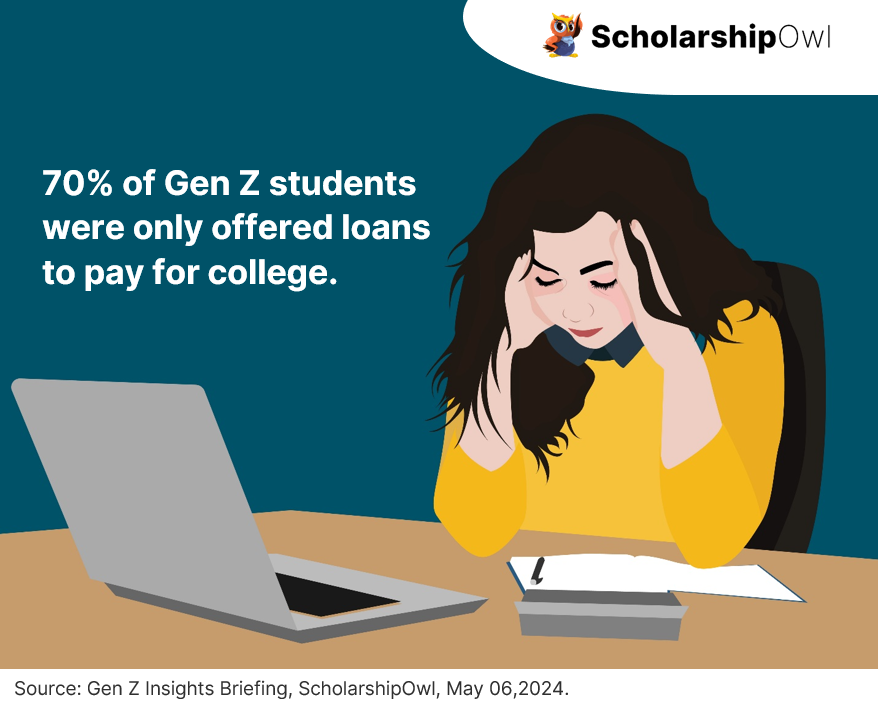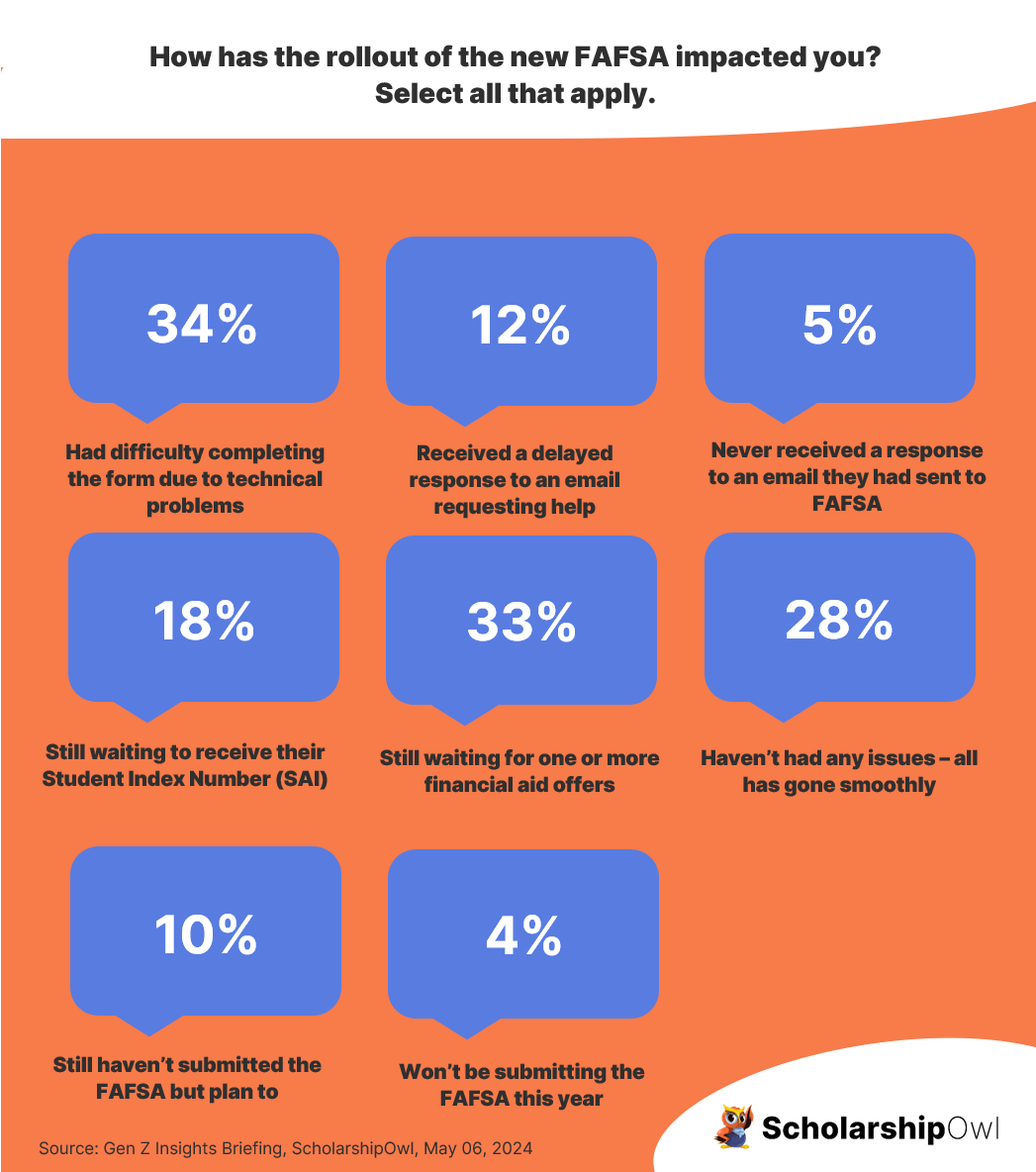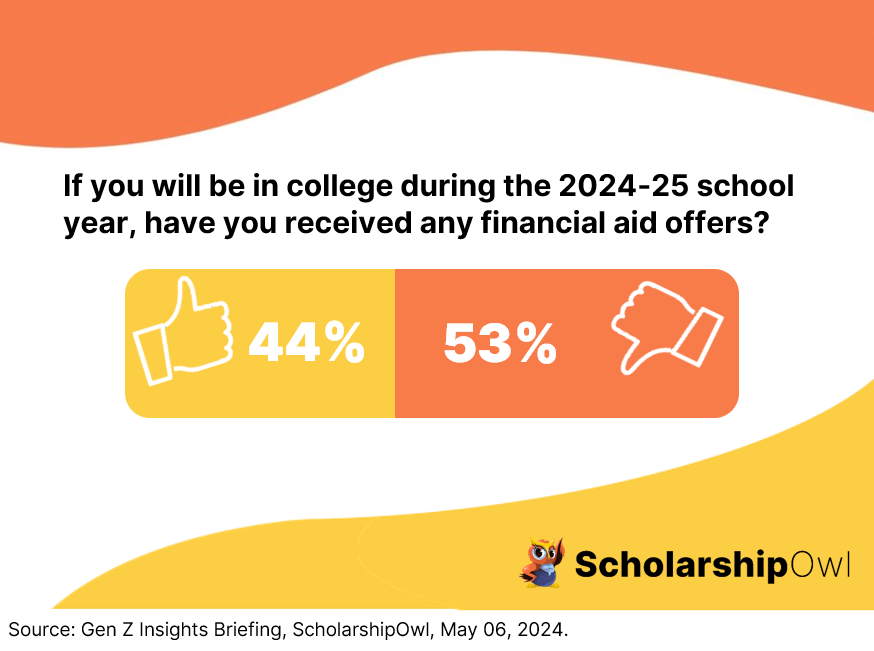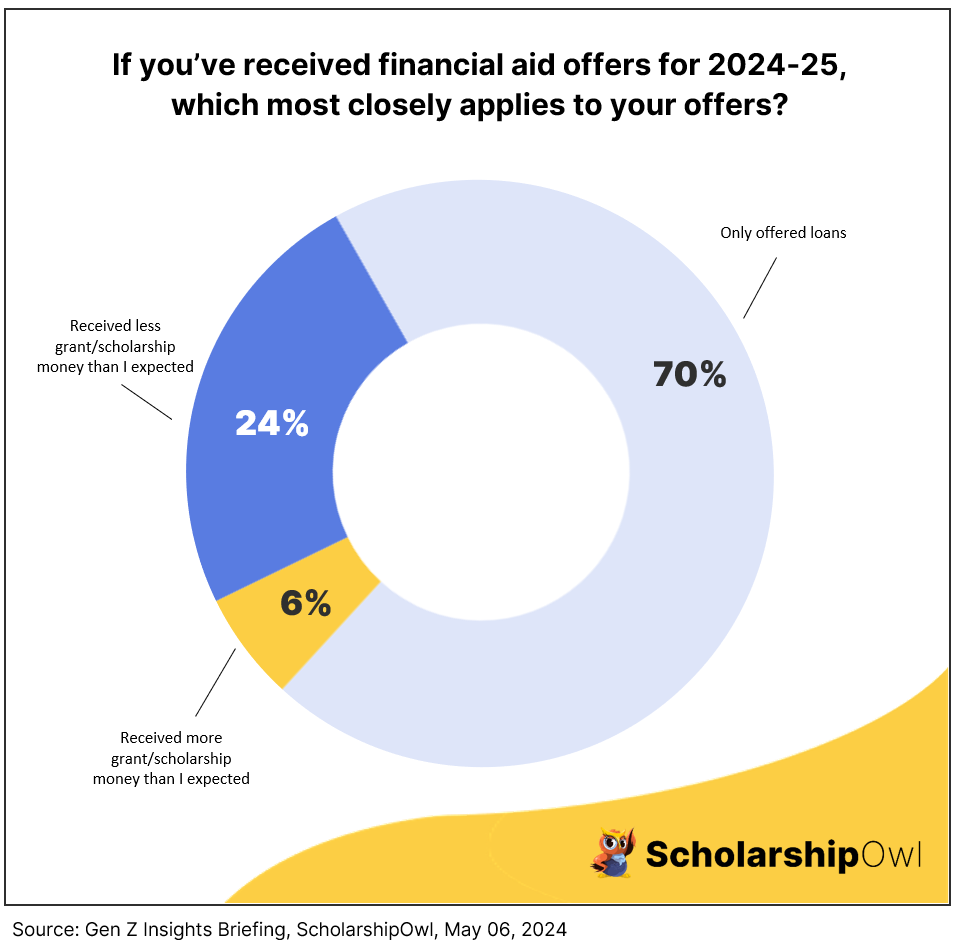In April 2024, ScholarshipOwl conducted a survey to help us develop a better understanding of the true impact of the troubled rollout of the new Free Application for Federal Student Aid (FAFSA) on Gen Z students. We began studying this topic earlier this year, and presented our results in April 2024. Our April survey delved further into the topic, focusing on whether or not students had begun receiving their financial aid offers. In more recent years, students have typically received their financial aid offers by the end of March, with many offers arriving prior to March. But as expected, the rollout of the new FAFSA has unfortunately resulted in significant delays, with less than half of our respondents (44%) receiving even one financial aid offer as of the date they completed the survey. Even more frustrating is that the majority of students we surveyed who had received one or more financial aid offers received less grant and scholarship aid than they had anticipated, with 70% responding that they didn’t receive any grant or scholarship offers – they were only offered loans.

Who participated in the survey?
In April 2024, ScholarshipOwl surveyed high school and college students on the ScholarshipOwl scholarship platform to delve more deeply into the impacts of the challenges related to the rollout of the new FAFSA. A total of 8,708 students responded.
Among the respondents, 61% were female, 38% were male, and 2% identified themselves as other. Nearly half (46%) were Caucasian, 23% were Black, 187% were Hispanic/Latino, 67% were Asian/Pacific Islander and 6% identified as other.
The fastest path to earning scholarships
Simplify and focus your application process with the one-stop platform for vetted scholarships.
Check for scholarshipsOver half (59%) of the respondents were high school students, with the vast majority high school seniors; nearly one-third (32%) were college undergraduate students, primarily college freshmen and college sophomores; 7% were graduate students and 3% identified themselves as adult/non-traditional students.
Survey questions
Question 1
We began the survey by asking students, “How has the rollout of the new FAFSA impacted you? Select all that apply.”
- 34% said they had difficulty completing the form due to technical problems with the FAFSA website;
- 12% said they received a delayed response to an email they sent to FAFSA because they needed help completing the form;
- 5% said they never received a response to an email they had sent to FAFSA;
- 18% said they are still waiting to receive their Student Aid Index (SAI) Number from FAFSA;
- 33% said they are still waiting for one or more financial aid offers from the colleges they’ve applied to;
- 28% said they haven’t had any issues, that everything has gone smoothly for them;
- 10% said they haven’t yet submitted the FAFSA this year, but they still plan to do so;
- 4% said that they won’t be submitting the FAFSA this year.

Question 2
The next question was, “If you will be in college during the 2024-25 school year, have you already received one or more financial aid offers from the colleges you applied for and/or will be attending?”
- 44% said yes
- 53% said no
- 3% said they won’t be in college in 2024-25

Question 3
The final question was, “If you have received one or more financial aid offers from colleges from the 2024-25 school year already, which of the following most closely applies to what you received in your financial aid offer(s)?”
- 6% said they received more money through grants/scholarships than they had expected;
- 24% said they received less money through grants/scholarships than they had expected;
- 70% said they received no grants or scholarships at all – they were only offered loans.

Key takeaways
Numerous media outlets have reported that the rollout of the new FAFSA has encountered technical issues as well as delays in general; however, the expectation has been that these difficulties would be worthwhile, as the U.S. Department of Education’s FAFSA website indicates that the changes to the FAFSA are expected to result in 610,000 new students will be eligible for a federal Pell Grant, and an additional 1.5 million students will also be eligible to receive a maximum Pell Grant award. Unfortunately, these predictions are not likely to be accurate. According to the National College Attainment Network’s FAFSA Tracker, just 36% of this year’s high school seniors had submitted the new FAFSA as of April 26, 2024, which is down 24% compared to last year.
The results of our survey unfortunately further demonstrate that the U.S. Department of Education’s predictions were loftier than the reality. Among our respondents who had received at least one financial aid offer from a college, just 6% received more money through grants/scholarships than they had expected. Among the remaining respondents, 24% said they received less money through grants/scholarships than they had expected, while 70% were only offered loans.
What steps can students take to ensure they can afford college?
There are a number of steps that students can take to ensure they have an affordable path to college:
- If you plan to attend college in 2024-25, it is imperative that you submit your FAFSA right away. If you haven’t yet, submit it today at www.fafsa.gov.
- If you are still waiting to receive one or more financial aid offers from colleges you applied to, contact each college’s financial aid office to ask for a status on your financial aid offer. Ask them if there is any information or documentation that you can submit that will make it easier for them to get their financial aid offer to you.
- If you are disappointed with any financial aid offers you’ve received, and if you feel that you can document why you should receive a better offer, contact the college’s financial aid office and ask them to explain how to appeal your financial aid award. Follow the steps they describe and submit your appeal right away. Note that for your appeal to have a chance at success, you’ll need to be able to explain and document why you feel your financial aid offer is incorrect. For example, if your parent/guardian recently lost their job, or if your family has large medical bills, you would need to submit documentation to support your assertion.
- Prioritize applying for scholarships with ScholarshipOwl.
- Apply for scholarships from the universities you are applying for and/or are currently attending; if you’ve already applied for these scholarships, contact the financial aid office to ask for a status on your application.
- Work part-time during the school year and full-time during breaks. Save your earnings to use for your college education.
- Once you do receive your financial aid offers, compare them and focus on choosing the most affordable college. If your first-choice school offered you a less financial aid and scholarships than other schools offered, contact your preferred school to see if you can negotiate your offer to one that is more affordable for you.
- Always consider starting at a community college, which offers a truly affordable option – and don’t forget that community colleges also offer federal and state grant aid, and they also offer scholarships. So even if you are planning to attend community college, always submit your FAFSA and always apply for scholarships!
REMEMBER: Student loans should always be a last-resort option for paying for college. Focus on debt-free sources that will enable you to graduate without the burden of owing thousands of dollars for college! Focus on applying for scholarships and jobs, NOT loans, so that you can graduate debt-free. There IS an affordable path to college – for further information, and to start applying for scholarships, visit www.scholarshipowl.com.



